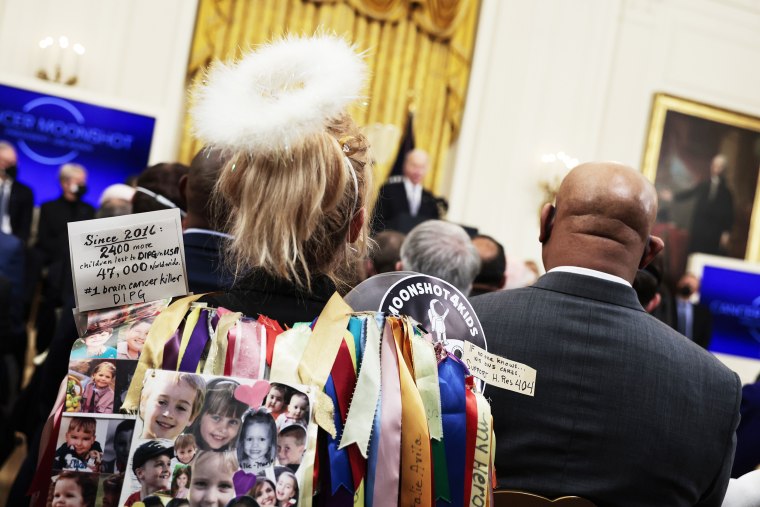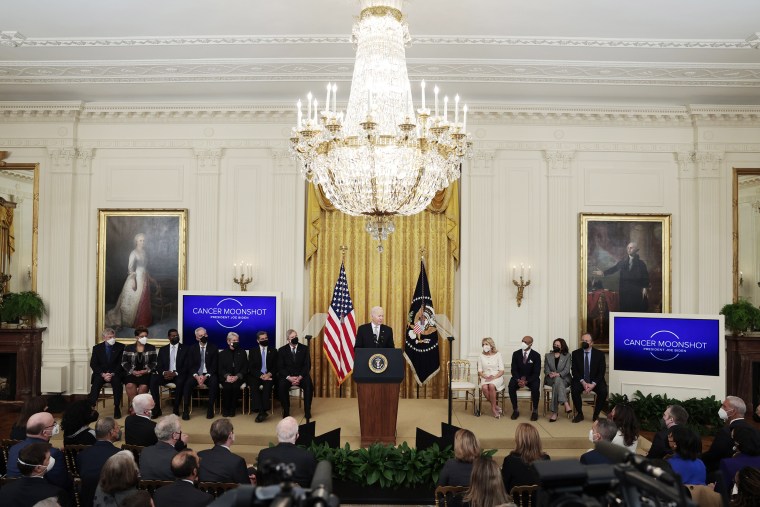President Joe Biden’s ambitious “Cancer Moonshot” relaunch will not only prevent deaths, it could also significantly improve the quality of life of those who survive cancer, experts say.
At the heart of Biden’s reignited initiative, announced Wednesday, is a lofty goal to reduce the mortality rate by at least 50 percent over the next 25 years of a disease that is expected to kill 609,360 people in the United States in 2022 alone.
That could mean millions more cancer survivors — a group that can face long-term health struggles. And Biden’s plan includes a focus on enhancing the experience of surviving cancer, news that was welcomed by oncologists, patient advocates and researchers.
“We’re not going to eradicate cancer. That isn’t going to happen. But we will manage it better,” said Gloria Petersen, a professor of epidemiology at the Mayo Clinic who has researched pancreatic cancer, one of the deadliest types of cancer, for more than two decades.
“What we like to think is it will not be considered a fatal, lethal disease. It will become a chronic disease,” she added. “So the attention on survivorship is really critical.”
“What we like to think is it will not be considered a fatal, lethal disease. It will become a chronic disease.”
Experts say more information is desperately needed about what types of health issues cancer survivors face after treatment, especially as new therapies emerge. Some treatments can put survivors at risk of developing a second cancer. Survivors of childhood cancer are at risk for a host of potential health issues later in life, including heart problems.
Dr. Charles Roberts, executive vice president at St. Jude Children’s Research Hospital and director of the hospital’s Comprehensive Cancer Center, said he was excited to see how the renewed Cancer Moonshot program could further advance understanding of childhood cancers, for which the five-year survival rate has risen to 80 percent in recent decades.
“We’ve proven that we can deliver better” when it comes to treatments, he said. “As cure rates are going up and more and more children are surviving and have decades of life ahead of them, the number of Americans that are survivors of childhood cancers is growing markedly, so we need to understand that impact on their lives.”
Can Biden’s objective be met?
Biden’s multi-pronged effort aims to boost screening, detection and prevention of the more than 200 types of cancer that exist and is a revamp of the original plan he oversaw in 2016 as vice president, a year after his son Beau died of brain cancer. As a result of the original program — which tried to compress a decade’s worth of cancer prevention, diagnosis and treatment advances into five years’ time — Congress authorized $1.8 billion to be spent over seven years, little of which remains.
It was not immediately clear where the funding for Biden’s fresh efforts would come from, although the president said he hoped Congress would see the matter as a bipartisan issue and back it.
The advances since the original Cancer Moonshot have been undeniable, experts said, with new types of therapies that are helping patients live longer after diagnosis, changes to screening guidelines and advances in blood tests that can detect cancer.
For this version of his plan, Biden on Wednesday used a phrase he has often repeated: “We can end cancer as we know it.”
His main objective of reducing the mortality rate by 50 percent in the next quarter-century is likely attainable, said American Cancer Society CEO Karen Knudsen, one of about 100 people in attendance at the White House gathering when Biden made his announcement.

While major progress has been made on lowering cancer deaths, Knudsen said a 50 percent reduction in 25 years might not happen without such a push — particularly given the disparate rates of mortality between various types of cancer, plus unexpected rising incidence of certain cancers, such as early onset colorectal cancer.
“It’s not a fait accompli that we would reach 50 percent,” she said.
Dr. Deb Schrag, chair of medicine at Memorial Sloan Kettering Cancer Center, was also optimistic that Biden’s mortality reduction goal would be achievable within 25 years, or possibly sooner, although she called that a “stretch goal.”
“It’s a much more realistic goal than we’ve heard in the past: ‘curing cancer,’ ‘eradicating cancer.’”
“There’s a lot of uncertainty, but it’s a much more realistic goal than we’ve heard in the past: ‘curing cancer,’ ‘eradicating cancer,’” she said. “Cancer is a disease of aging. It’s many different diseases. We know that if men live long enough, there’s very likely to be some prostate cancer.”
Reducing your chances of cancer
The experts said they hoped lung cancer and other cancers associated with tobacco use would decline in the coming decades as smoking rates go down, but they said they worried that cancers associated with obesity, such as uterine and pancreatic cancer, could rise.
Dr. Maha Hussain, a medical oncologist and deputy director of the Robert H. Lurie Comprehensive Cancer Center of Northwestern University, said a continued focus on prevention and screening was critical to meeting the rest of the goals in Biden’s plan.
“The best thing is to not get cancer, and that’s what we need to invest in, so definitely prevention,” she said. “And if you get cancer, we want to make it something that can be treated, so early detection. The next step would be making cancer a chronic disease as opposed to an acute, deadly disease.”
While the existence of cancer may be inevitable, getting it is not, and lifestyle changes can decrease your chances.
Besides eating well and exercising regularly, there are additional ways to take control of your health, Knudsen said.
“Ask your physician, ‘What is the right cancer screening plan for me?’” she said. “If every American adopted their right screening strategy, we could fundamentally change cancer in this country.”

